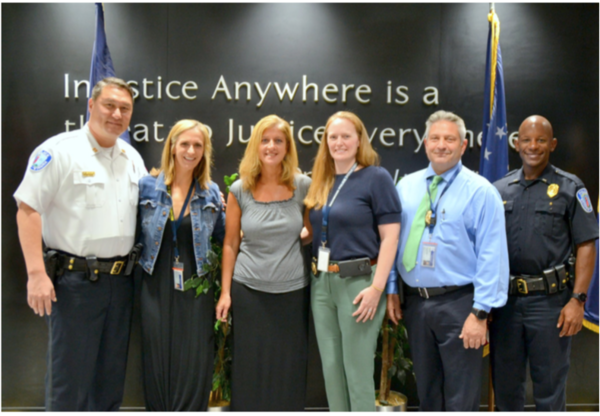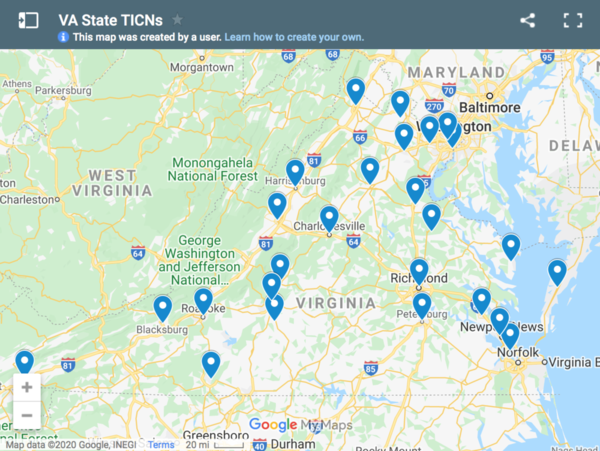In the fall of 2012, Jeanine Harper, Melissa McGinn, and Lisa Wright were hearing more and more about adverse childhood experiences and trauma-informed practices. Feeling inspired, their organization, Greater Richmond SCAN (Stop Child Abuse Now) and five other community partners hatched a one-year plan to educate the Richmond, Virginia, community about ACEs science and to embed trauma-informed practices.
Eight years later, the original group has evolved into the Greater Richmond Trauma-Informed Community Network (GRTICN) with 495 people and 170 organizations. They have a solid foothold in infusing ACEs science throughout the Greater Richmond community. Inspired by their work and facilitated by their knowledge, there are now Trauma Informed Community Networks in 26 cities and towns across Virginia. The statewide coalition is called the Virginia Trauma Informed Community Networks. (McGinn is SCAN's community programs coordinator and coordinates the state's trauma informed community network; Wright is the GRTICN coordinator, in additional to her work as a therapist at SCAN; Harper is SCAN’s executive director.) And, despite the advent of COVID-19 into every community across the state, GRTICN and the other communities in the network hosted the state’s first Resilience Week May 3-9, 2020, with virtual events all across the state.
Although it’s a foothold, that progress still significant because now a notable portion of the community says it will never stop integrating ACEs science. But the more they do, the more they realize there’s still a long way to go.
“We did think it was going to be a shorter process,” says Wright about the last eight years and not without some irony. “As I reflect back, I am amazed that our plan was to complete so much in just one year and astounded by how the initiative created a ripple effect across so many sectors and disciplines.”
However, with the COVID-19 pandemic and the extraordinary shifts in White America’s understanding of Black historical and present systemic racism, Wright, McGinn and others in the GRTICN see this time as an opportunity to make an even greater impact in changing harmful policies and practices in many of their communities’ systems. They don’t feel as if they have to convince people ACEs science is real any more. But now they need to measure their progress. That’s why the GRTICN is becoming an affiliate of ACEs Connection Cooperative of Communities. They’re the first ACEs initiative to do so.
The ACEs Connection Cooperative of Communities is a program of ACEs Connection that provides special tools and services for ACEs initiatives in towns, cities, and counties. It’s designed for initiatives that need efficient and sophisticated ways to measure their progress to becoming a trauma-informed community; that want diversity, equity and inclusion coaching; whose members need training in how to be a network leader…in other words, established initiatives that are ready to move to the next level.
Here’s the thing about this new knowledge of ACEs science. You pull one thread. That leads to pulling more threads. Pretty soon you realize that you’ve got a bunch of threads that you’re weaving into a whole new tapestry. A different picture starts to emerge about how to change human behavior. Instead of integrating policies and practices based on blame, shame and punishment, you’re integrating practices based on understanding, nurturing and healing. And pretty soon you’re on the way to solving your most intractable problems.
The work is essential, the stakes are huge, the promise game-changing.
First, let me say that I will not do justice in this blog post to all that GRTICN has accomplished over the last eight years. It’s mind-boggling. Consider this overview a greatly abbreviation version of their accomplishments, so, I encourage you to check out the links.
“Yep,” says Wright. “We could do a better job at letting people know what we do.”
Wright and McGinn point out that integrating ACEs-science informed practices takes much longer than a year. They say that the essential foundation for making changes driven by people from different walks of life includes taking the time to develop relationships, developing a common language, and tackling tiny challenges to demonstrate early achievements, which helps inspire commitment and propel people toward taking on big challenges. They’ve done all that to accomplish a long list of changes:
- They led efforts for new language in the Virginia State Board of Education regulations to require trauma-informed courses for university K-12 teaching programs.
- They led efforts for a resolution in the state legislature to recognize the 26 trauma-informed community networks as a best practice model.
- They provided consultation and technical assistance to organizations about the process of becoming more trauma-informed. These organizations were in the sectors of child welfare, law enforcement, juvenile courts, schools, and health systems.
- They lead the Richmond City Police Department’s Road 2 Resilience initiative, which has trained more than 500 sworn officers in an introduction to trauma and resilience.
- They facilitated the education of more than 10,000 people about ACEs science.
- They provide consultation and technical assistance to support the development of trauma-informed community networks across Virginia and convene meetings of the statewide TICN network.
- They participate in the development of Voices’ Campaign for a Trauma Informed Virginia and worked with VAKids.org to support 12 pieces of legislation that include funding for local ACEs initiatives and continued training about ACEs science for community members.
- They’ve screened the documentary Resilience more than 200 times to more than 6,000 people.
The people behind all these accomplishments work on one of nine committees. Here are a few highlights.
The Healthcare Committee was set up as a learning collaborative for organizations who are at different stages of implementing trauma-informed practices and policies into their settings. These organizations include community health clinics, hospital systems, managed care companies, public health departments, private pediatric clinics, yoga and other wellness studios.

“Lots of people want to make policy and practice changes,” says McGinn, who leads the committee. “Some organizations are further along than others.” GRTICN also assisted the three major health systems (VCU Health, Bon Secours, and HCA Virginia in launching the local Trauma-Informed Health Systems Collaborative in 2017. McGinn serves as the project manager for this initiative. Each of the three health systems and the Virginia Premier Health Plan, established trauma-informed leadership teams and decided to start their work in pediatric departments. ACEsConnection will do a separate blog post about that effort.
Since the pandemic hit, participants have been focusing on sharing good ideas to foster staff wellness.
“VCU Health, the largest hospital in Richmond has put Zen spaces on many floors,” says McGinn, “where nurses and doctors can rese’ before they have to go to the next hard thing.” Each room has food, soothing lighting, motivational signs, scent diffuser, comfortable seating, and items such as stress balls and coloring books.They also created a peer mentor model and trained several people to be mentors for the staff. That person walks the corridors to check in with staff members informally to see how they’re doing and offer an ear, a shoulder to cry on, or other resources. “They don’t have a structure,” she says. “There’s no reflective supervision. The staff likes it.”
The Legal/Courts Committee members helped the Richmond Police Department set up the Road 2 Resilience project, which has trained more than 500 law enforcement officers in trauma-informed practices such as trauma exposure responses, impact of trauma exposure and trauma-informed supervision. They also do ongoing research about the effects of trauma on police.
Road to Resilience project members: (Left to right) Cpt. Don Davenport, Elaine Minor, Lisa Wright, Sgt. Adrienne Gardner, Sgt. Frank Scarpa & Lt. Anthony Jackson
_________________________________________
The committee, led by Wright, has also worked with local courts to create trauma-informed environments, which include providing privacy for people applying for protective orders, distributing parent handouts about trauma in some public spaces, and providing a witness box was moved to increase the physical space between victims and their alleged perpetrators, so that people who are testifying against people they fear don’t have to walk past or testify near them.
The largest committee is the Schools Committee. Its more than 90 members include classroom teachers, after-school teachers, parents, school nurses, administrative staff, etc. It’s currently working on developing guidelines for returning to school and is participating in a state-level workgroup convened by the governor to do the same.
The Training Committee was very active early on, because GRTICN members were doing most of the training about ACEs science when there wasn’t as much information available about it. Over the years, they’ve educated more than 10,000 people about ACEs science. Two years ago, the Department of Behavioral Health and Developmental Services received a state grant to fund the ACE Interface train-the-trainers training about ACEs science.
The members of the training committee still hold 90-minute online trainings every two months for 75-100 people. “It fills up every time,” says McGinn. “A lot of agencies use it for onboarding new staff, volunteers, and board members.”
They’re continuing to at look at the gaps and needs in the community, as they have for the last eight years, and will use the tools offered by the ACEs Connection Cooperative of Communities to help assess and measure those gaps and needs.
Although they will tell you that this process has been more or less made up by all concerned as they went along—in other words, they had no blueprints—McGinn and Wright point out two big lessons learned.
“Since our initial goal was on improving practices and policies within the child welfare system, we began by being professionally driven,” says McGinn. “We’ve had to work backwards, to be more community driven. We’re providing more guidance to new TICN communities so that from the beginning they’re community-driven.” The Southside Trauma-Informed Community Network (STICN) is a good example of a community-driven initiative. Its members held meetings at local libraries, sponsored community awareness events and invited anyone to join. In 2019, STICN held an ACEs summit in Petersburg where they held workshops examining the intersection of ACEs, trauma, racism poverty, and equity.
“They included a lot of youth voices and community members testifying about their own stories,” says McGinn.
Although in-person meetings halted as a result of the pandemic, says McGinn, “the work of GRTICN has continued at an accelerated pace.” One example is the integration of the North Carolina Project Broadcast Screening tool, which was developed for child welfare workers in North Carolina. It’s meant to help social workers screen for additional assessment of trauma. The tool is brief and comprises questions for caregivers and other professionals regarding trauma history, symptoms and behaviors.
“There are only four questions asked of children ages seven and older,” says Wright. “The departments piloting the tool are using other measures to assess the caregiver/family and resilience in the family. They vary in which ones that they use, but all agencies have been very cognizant to assess the whole family and to have a strengths-based approach.”
The other example is the work of the community resilience committee.
“Since COVID hit,” says McGinn, “the committee has been hosting community conversations for neighborhoods in the City of Richmond. COVID is hitting minority neighborhoods disproportionately. We identified several different ways of hosting the conversations, including Zoom, phone, Facebook Live chats, Instagram conversations. We wanted to elevate the voice of the community. A lot of well-intended people wanted to supply food, but we asked communities what resources they needed.” The community responded with a list of additional items they needed, including wifi hotspots, personal care items, making food distribution more accessible to certain communities, and COVID-19 testing.
They’ve also expanded their work in supporting anti-racist activities.
“We had one of our members who works at the Virginia Center for Inclusive Communities facilitate a discussion about diversity, equity and inclusion for our network,” says Wright, who notes that GRTICN is bringing a DEI lens to all of its work, including the Legal and Courts committee. “We know that there’s a disproportionate representation of minorities in the juvenile justice system. We’re talking about what we can do about that.”






Comments (0)